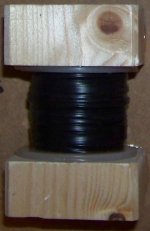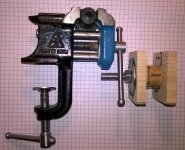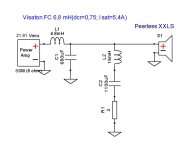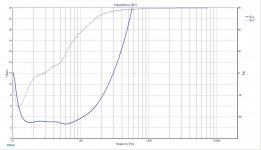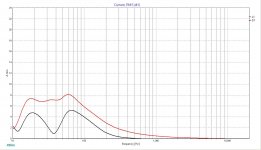I have a pair of surplus Scan Speak D2905-9500 tweeters that I would like to put to use in a pair of 2-way speakers. In a previous thread I was advised to look at these:W1501/
The woofers are available for AUD260 each. The tweeters sell for AUD163 each. I haven't costed the crossover components yet, but I'm guessing the total cost of these small bookshelf speakers will be around AUD1000 (USD750). Certainly not cheap! As I already have the tweeters, I suppose the real cost to me is around AUD650.
All of my previous speaker projects have used either Linkwitz active crossovers or a DSP instead of passive crossovers. I would appreciate it if someone could checkout the crossover in the link above and let me know a good supplier of the components. A supplier in Australia would be ideal, but any advice gratefully accepted.
Cheers,
Chris
The woofers are available for AUD260 each. The tweeters sell for AUD163 each. I haven't costed the crossover components yet, but I'm guessing the total cost of these small bookshelf speakers will be around AUD1000 (USD750). Certainly not cheap! As I already have the tweeters, I suppose the real cost to me is around AUD650.
All of my previous speaker projects have used either Linkwitz active crossovers or a DSP instead of passive crossovers. I would appreciate it if someone could checkout the crossover in the link above and let me know a good supplier of the components. A supplier in Australia would be ideal, but any advice gratefully accepted.
Cheers,
Chris
Speakerbug are very good for high quality Xover parts, (Jantzen etc). WES components are good for generic parts and drivers (Peerless, Scanspeak etc). Both have websites.
Thanks for the link. I just priced the inductors and caps at AUD310 for the pair of speakers. That makes these speakers a $1200 project. Too much for me.
Back to the drawing board.
Back to the drawing board.
Thanks for the link. I just priced the
inductors and caps at AUD310 for the pair of speakers.
That is not the best way to diy a project. Those filter parts types and values
are programmed to be expensive. There is alternatives but one has to believe
in it. I'd either source locally magnet wire and wind my own coils with the
help of ferrite sticks and find in general electronics stores good value caps.
That should lower the costs considerably. The other way is to get higher values
ferrite core inductors and remove the excess wire to meet the mH spec for
all the coils you need. The dcr will already be very low.
Last edited:
Thanks. I suppose I could wind my own inductors. I have a metal lathe that can be run at very slow speed (<<1 RPM). I could easily make formers to wind the coils on.
Noob question- are air-cored inductors better for crossovers than ferrite cored?
Noob question- are air-cored inductors better for crossovers than ferrite cored?
crossover components
Parts express carry Dayton caps they are very good and fair price. And Madisound carry Bennic witch are also good and affordable. And Erse audio have affordable caps and good inductors.
https://www.madisoundspeakerstore.com/horn-tweeters/
Parts Express: the #1 source for audio, video & speaker building components
Premium grade audio components including crossover inductors, audio capacitors, electronic assemblies | ERSE Audio
Parts express carry Dayton caps they are very good and fair price. And Madisound carry Bennic witch are also good and affordable. And Erse audio have affordable caps and good inductors.
https://www.madisoundspeakerstore.com/horn-tweeters/
Parts Express: the #1 source for audio, video & speaker building components
Premium grade audio components including crossover inductors, audio capacitors, electronic assemblies | ERSE Audio
Thanks. I suppose I could wind my own inductors. I have a metal lathe that can be
run at very slow speed (<<1 RPM). I could easily make formers to wind the coils on.
Noob question- are air-cored inductors better for crossovers than ferrite cored?
Anyone who builds diy speakers, most certainly could do the same with inductors.
A software calculator would give you a rough idea how much wire and what dcr
it will have and in practice you would see how good the predictions were after measuring.
It is known that ferrite inductors start to saturate at a certain current value
which is just about a good reason for the golden eared audiophiles to freak out
about it even then when they know they are in the safe zone. Air cored don't do that.
Check Visaton web for specs.
edit: This is an inductor on a bobbin for the solder wire and the ferrites are
within.
Attachments
Last edited:
Thanks Sean & Lojzek. Which calculator do you use Lojzek?
I found some iron core inductors on Madisound that were much cheaper than the equivalent air-cored version.
I found some iron core inductors on Madisound that were much cheaper than the equivalent air-cored version.
Noob question- are air-cored inductors better for crossovers than ferrite cored?
Especially in low pass filters I highly prefer cored inductors with a bigger core and less but thick wire.
Lower DCR, lower interwinding capacitance.
I use an ancient speaker program that you can't find anywhere
but RonE has put a link on the subject with formulae a few days
ago. Thanks Ron!
Wheeler Formulas for inductance
but RonE has put a link on the subject with formulae a few days
ago. Thanks Ron!
Wheeler Formulas for inductance
The ERSE I-core inductors that parts-express sell are cost effective if you need a large value and low ESR. From my testing it takes about 11Amps peak (>500Watts @ 8ohm) to drive them into saturation, so no audible issues with them only having to handle a small single woofer each.
I mostly buy the 20AWG Jantzen air cores and the 18AWG ERSE I-cores from parts-express. Shame about the AUD-USD exchange rate at the moment though. From time to time I wind my own (on wooden bobbins or plastic bobbins from reels of solder/wire), or overwind/unwind what I already have to suit but I find it a chore so unless it's only a small inductor I need to make or a minor rewind job then I'd rather just buy a new one.
For capacitors I have built up a stockpile of plastic film caps (PET and Polypropylene) from element14. If from time to time you just browse plastic film caps set a filter 1uF to 100uF, 100V+ and sort by price you can come across a bargain. Parts-express' cheaper electrolytics are fine if you need a larger value and aren't building a crossover for a monster woofer.
I mostly buy the 20AWG Jantzen air cores and the 18AWG ERSE I-cores from parts-express. Shame about the AUD-USD exchange rate at the moment though. From time to time I wind my own (on wooden bobbins or plastic bobbins from reels of solder/wire), or overwind/unwind what I already have to suit but I find it a chore so unless it's only a small inductor I need to make or a minor rewind job then I'd rather just buy a new one.
For capacitors I have built up a stockpile of plastic film caps (PET and Polypropylene) from element14. If from time to time you just browse plastic film caps set a filter 1uF to 100uF, 100V+ and sort by price you can come across a bargain. Parts-express' cheaper electrolytics are fine if you need a larger value and aren't building a crossover for a monster woofer.
Last edited:
for excellent value crossover caps I don't think you can go past the axon's from parts connexion AXON True Cap Metallized Polypropylene Capacitors They are what I used in my crossover for my MTM's.
I also built my own coils. http://www.diyaudio.com/forums/blog...g-your-own-adventure-coil-winding-part-i.html
I would think with those two options you could make your crossovers for a lot less than $300 I think I paid about $50 for the magnet wire (14ga equivalent) but that was when copper was at its most expensive, should be a lot cheaper now.
Tony.
I also built my own coils. http://www.diyaudio.com/forums/blog...g-your-own-adventure-coil-winding-part-i.html
I would think with those two options you could make your crossovers for a lot less than $300 I think I paid about $50 for the magnet wire (14ga equivalent) but that was when copper was at its most expensive, should be a lot cheaper now.
Tony.
The SS 15W's shine best for bass in a 15L cabinet. You should consider building or buying cabinets that size.
Do a search on "Intimates" at Parts Express TechTalk forum to see some FR data on a 15L design with the same drivers. The tweeters were my first iteration and I used a capless XO design originated by Sonus Faber in their infamous Extrema model.
Do a search on "Intimates" at Parts Express TechTalk forum to see some FR data on a 15L design with the same drivers. The tweeters were my first iteration and I used a capless XO design originated by Sonus Faber in their infamous Extrema model.
Thanks to everyone for the sources of parts.
Hey, thanks for the heads-up speakerdoctor. I've only had a quick scan of the thread but they look great. Are you carlspeak on that forum?
The SS 15W's shine best for bass in a 15L cabinet. You should consider building or buying cabinets that size.
Do a search on "Intimates" at Parts Express TechTalk forum to see some FR data on a 15L design with the same drivers. The tweeters were my first iteration and I used a capless XO design originated by Sonus Faber in their infamous Extrema model.
Hey, thanks for the heads-up speakerdoctor. I've only had a quick scan of the thread but they look great. Are you carlspeak on that forum?
Getting passive crossovers calibrated is a pain in the rump. I'm a huge fan of building active xovers, which are easily predictable, and do a much cleaner job (I verify the outcome with a free 5SPICE circuit modelling program before building). Once I've got a chassis with a power supply for the xover, I also add active EQ to bring up the low bass, that is inveriably rolled off too soon. I usually pump up 30HZ by 10dB with a fast rolloff below that, and have a 4 section Baxandall tone circuit to tailor it from there. Who doesn't want good low bass? Then the project could be worth it.
re:"It is known that ferrite inductors start to saturate at a certain current value
which is just about a good reason for the golden eared audiophiles to freak out
about it " - yes, but only if you're running them at PA levels, in which case you should be using active xovers anyway (or you're deaf...)
Chris, consider pairing your tweeters with better value mid-bass drivers, in Aus the SB drivers from Wagner come to mind...
which is just about a good reason for the golden eared audiophiles to freak out
about it " - yes, but only if you're running them at PA levels, in which case you should be using active xovers anyway (or you're deaf...)
Chris, consider pairing your tweeters with better value mid-bass drivers, in Aus the SB drivers from Wagner come to mind...
Chris, consider pairing your tweeters with better value mid-bass drivers, in Aus the SB drivers from Wagner come to mind...
Thanks Pete. The SB drivers are certainly a lot cheaper than the Scan Speak. The 6.5" paper cone mid-woofer might be a reasonable substitute for the Scan Speak. I'll have a look at the specs when I get a chance later.
Chris
yes, but only if you're running them at PA levels, in which case
you s hould be using active xovers anyway (or you're deaf...)
It depends on the implementation. Very interesting as an excercise
is this sim of the Peerless XXLS in a 100 litre BR cabinet. Although
Bill's XSim shows Current peak by default, I have modified the voltage
input to meet the Current graph show actual Irms values. The red curve
represents ferrite inductor Visaton, the black a driver. It took only 60W
to get 7 Arms through the inductor.
Attachments
- Status
- Not open for further replies.
- Home
- Loudspeakers
- Multi-Way
- Sourcing Crossover Components
